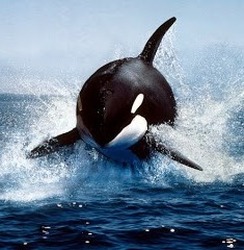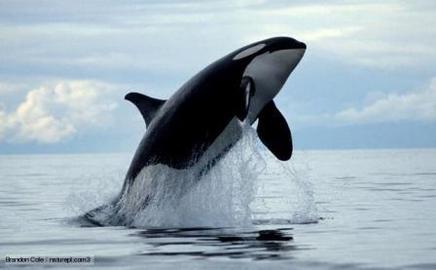Killer WhaleOrcinus Orca |

Custom Search
|
|
The Killer Whale or orca whale (Orcinus Orca) isn't actually a whale but the largest member of the dolphin family.
Killer whales can be found in all oceans of the planet and also in many of the smaller seas like the Mediterranean where the species often makes incursions up to the Balearic Islands. However, the species avoids the warmer waters in the vicinity of the equator and appears less frequently in the Pacific Ocean. They prefer the colder seas near polar circles the Arctic and the Antarctic. The male Killer whales, despite their minor importance in the group and social hierarchy are significantly larger and heavier than females, and could reach 9.5 meters and weigh about 7500 kg, females hardly exceed 8.5 meters and 5000 kg. Together with their heavy and stocky body, they have the biggest dorsal fin of the animal kingdom, which can measure up to 1.8 meters in height (larger and more upright in males than in females).
These animals are characterized for having the dorsal black area and a white ventral area. They also have white spots on the back side of the body and above and behind the eyes.
Killer whales are the second largest group of mammals in terms of distribution throughout the earth, right after humans. Given the wide distribution of the Killer Whales across the planet, the life expectancy of these animals varies greatly, depending on the area where you find them. It is thought that males can live between 40 and 50 years and the females up to 90 years. The Killer Whale swimming speed is around 10 to 13 km per hour, but, when chasing prey they can reach up to 55 km/h and can jump up to 12 meters long, and over one meter above the water. They can dive to a depth of 30 m (100 feet) to hunt. These family groups may have different constitutions, depending on the area of the planet where the group lives. However, they can have 12 to 50 animals in each zone and the groups are roughly similar. Killer Whale Diet
The food basis of the killer whale diet are seals like the Harbor Seal. Being excellent hunters these whales feed on octopus, fish, squid, sharks, turtles, penguins and seagulls. Occasionally, some species will attack and kill Blue whales and other whale species. As adults, these animals need to eat between 200/250 Kilos of food per day each. For this reason the XVIII century Spanish sailors have designated these animals "asesina of ballenas" (whale assassin). The term was later mistranslated into English as Killer Whale, but it became so frequent that even Portuguese adopted the translated term in their own language (Baleia Assassina). Killer Whale Reproduction Females reach sexual maturity after eight years, although the first offspring will only emerge many years later. Males reach maturity much later, around 15 years. These differences may be related to the fact that their groups are markedly matriarchal societies, where females play a preponderant role throughout their life. Pregnancy in this species lasts approximately twelve months, although it takes a little longer to occur in some females. After this time, only one young is born with about 2.5 meters and can weigh nearly 200 kilos. The suckling period lasts at least 12 months. The female killer whale will stay with her offspring for at least the first 2 years of life. The period between pregnancies, is very variable and can be anywhere from 3 or 3.5 years up to 8 years. Killer Whale Conservation status The conservation status of this species is near threatened, surveys suggest there are about 100,000 animals spread over all the seas of the world. The number of Killer Whales has declined alarmingly in recent years, the scientific community is aware of that and concerned and trying to combat the causes of this sharp decrease. The main threats which Killer whales face are hunting, the disappearance of food in quantity and pollution. The Killer Whale in Captivity The intelligence of killer whales and the ease in training them, as well as their appearance and their playfulness in captivity makes them a popular Animal for display in aquariums and aquatic shows. There are no known attacks on humans in the wild, although there are some cases of attacks on their trainers in aquatic parks.
|
Scientific classification
Kingdom: Animalia Phylum: Chordata Class: Mammalia Order: Carnivora Family: Mustelidae Subfamily: Lutrinae Genus: Pteronura Species: P. brasiliensis |



